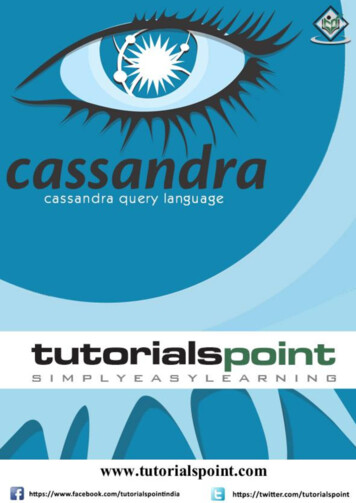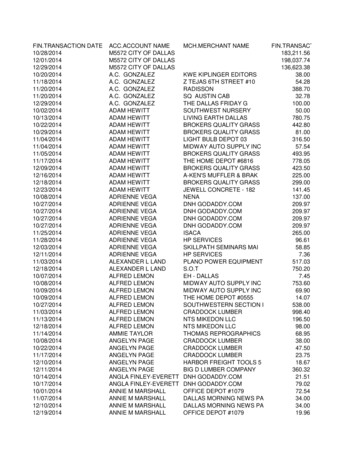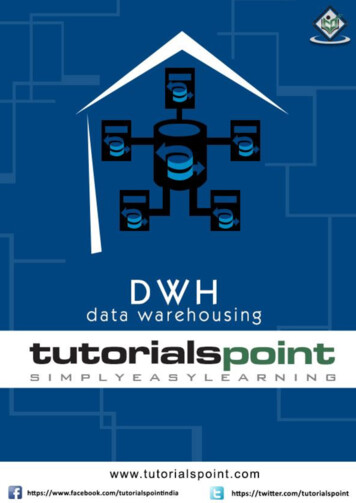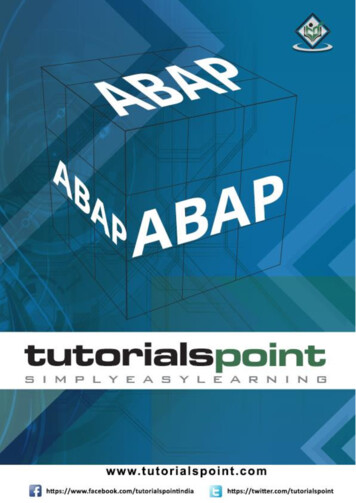
Transcription
Cassandrai
CassandraAbout the TutorialCassandra is a distributed database from Apache that is highly scalable and designed tomanage very large amounts of structured data. It provides high availability with no singlepoint of failure.The tutorial starts off with a basic introduction of Cassandra followed by its architecture,installation, and important classes and interfaces. Thereafter, it proceeds to cover how toperform operations such as create, alter, update, and delete on keyspaces, tables, andindexes using CQLSH as well as Java API. The tutorial also has dedicated chapters toexplain the data types and collections available in CQL and how to make use of userdefined data types.AudienceThis tutorial will be extremely useful for software professionals in particular who aspire tolearn the ropes of Cassandra and implement it in practice.PrerequisitesIt is an elementary tutorial and you can easily understand the concepts explained herewith a basic knowledge of Java programming. However, it will help if you have some priorexposure to database concepts and any of the Linux flavors.Copyright & Disclaimer Copyright 2015 by Tutorials Point (I) Pvt. Ltd.All the content and graphics published in this e-book are the property of Tutorials Point (I)Pvt. Ltd. The user of this e-book is prohibited to reuse, retain, copy, distribute or republishany contents or a part of contents of this e-book in any manner without written consentof the publisher.We strive to update the contents of our website and tutorials as timely and as precisely aspossible, however, the contents may contain inaccuracies or errors. Tutorials Point (I) Pvt.Ltd. provides no guarantee regarding the accuracy, timeliness or completeness of ourwebsite or its contents including this tutorial. If you discover any errors on our website orin this tutorial, please notify us at contact@tutorialspoint.comi
CassandraTable of ContentsAbout the Tutorial . iAudience . iPrerequisites . iCopyright & Disclaimer . iTable of Contents . iiPART 1: CASSANDRA BASICS . 11.Introduction . 2NoSQL Database . 2NoSQL vs. Relational Database . 2What is Apache Cassandra? . 3Features of Cassandra . 3History of Cassandra . 42.Architecture . 5Data Replication in Cassandra . 5Components of Cassandra . 6Cassandra Query Language . 73.Data Model . 8Cluster . 8Data Models of Cassandra and RDBMS . 114.Installation . 12Pre-Installation Setup . 12Download Cassandra . 15Configure Cassandra . 15Start Cassandra . 16Programming Environment . 16Eclipse Environment . 17Maven Dependencies . 185.Referenced API . 21Cluster . 21Cluster.Builder . 21Session . 216.Cassandra cqlsh . 23Starting cqlsh . 23Cqlsh Commands . 247.Shell Commands . 26HELP . 26CAPTURE . 26CONSISTENCY . 27COPY . 27DESCRIBE . 28DESCRIBE TYPE . 29DESCRIBE TYPES . 30ii
CassandraExpand . 30EXIT . 31SHOW . 32SOURCE. 32PART 2: KEYSPACE OPERATIONS . 338.Create KeySpace . 34Creating a Keyspace. 34Replication . 34Durable writes . 35Using a Keyspace . 36Creating a Keyspace using Java API . 369.Alter KeySpace . 40Altering a KeySpace . 40Replication . 40Durable writes . 40Altering a KeySpace using Java API . 4210. Drop KeySpace . 45Dropping a KeySpace . 45Dropping a KeySpace using Java API . 45PART 3: TABLE OPERATIONS . 4811. Create Table . 49Create a Table . 49Creating a Table using Java API . 5112. Alter Table . 54Altering a Table. 54Adding a Column . 54Dropping a Column . 55Altering a Table using Java API . 55Deleting a Column . 5813. Drop Table . 59Dropping a Table . 59Deleting a Table using Java API . 5914. Truncate Table . 62Truncating a Table . 62Truncating a Table using Java API . 6315. Create Index. 66Creating an Index. 66Creating an Index using Java API . 6616. Drop Index . 69Dropping an Index . 69Dropping an Index using Java API . 69iii
Cassandra17. Batch Statements. 72Using Batch Statements . 72Batch Statements using Java API . 73PART 4: CURD OPERATIONS . 7618. Create Data . 77Creating Data in a Table . 77Creating Data using Java API . 7819. Update Data. 82Updating Data in a Table . 82Updating Data using Java API . 8320. Read Data . 86Reading Data using Select Clause . 86Where Clause . 87Reading Data using Java API . 8821. Delete Data . 91Deleting Data from a Table . 91Deleting Data using Java API . 92PART 5: CQL TYPES . 9522. CQL Datatypes . 97Collection Types . 9823. CQL Collections . 99List . 99SET . 100MAP . 10124. CQL User-Defined Datatypes . 103Creating a User-defined Data Type . 103Altering a User-defined Data Type . 104Deleting a User-defined Data Type . 105iv
CassandraPart 1: Cassandra Basics5
1. INTRODUCTIONCassandraApache Cassandra is a highly scalable, high-performance distributed database designed tohandle large amounts of data across many commodity servers, providing high availability withno single point of failure. It is a type of NoSQL database. Let us first understand what a NoSQLdatabase does.NoSQL DatabaseA NoSQL database (sometimes called as Not Only SQL) is a database that provides amechanism to store and retrieve data other than the tabular relations used in relationaldatabases. These databases are schema-free, support easy replication, have simple API,eventually consistent, and can handle huge amounts of data.The primary objective of a NoSQL database is to have simplicity of design,horizontal scaling, andfiner control over availability.NoSql databases use different data structures compared to relational databases. It makessome operations faster in NoSQL. The suitability of a given NoSQL database depends on theproblem it must solve.NoSQL vs. Relational DatabaseThe following table lists the points that differentiate a relational database from a NoSQLdatabase.Relational DatabaseNoSql DatabaseSupports powerful query language.Supports very simple query language.It has a fixed schema.No fixed schema.Follows ACID (Atomicity, Consistency,Isolation, and Durability).It is only “eventually consistent”.Supports transactions.Does not support transactions.6
CassandraBesides Cassandra, we have the following NoSQL databases that are quite popular: Apache HBase: HBase is an open source, non-relational, distributed databasemodeled after Google’s BigTable and is written in Java. It is developed as a part ofApache Hadoop project and runs on top of HDFS, providing BigTable-like capabilitiesfor Hadoop. MongoDB: MongoDB is a cross-platform document-oriented database system thatavoids using the traditional table-based relational database structure in favor of JSONlike documents with dynamic schemas making the integration of data in certain typesof applications easier and faster.What is Apache Cassandra?Apache Cassandra is an open source, distributed and decentralized/distributed storage system(database), for managing very large amounts of structured data spread out across the world.It provides highly available service with no single point of failure.Listed below are some of the notable points of Apache Cassandra: It is scalable, fault-tolerant, and consistent. It is a key-value as well as a column-oriented database. Its distribution design is based on Amazon’s Dynamo and its data model on Google’sBigtable. Created at Facebook, it differs sharply from relational database managementsystems. Cassandra implements a Dynamo-style replication model with no single point offailure, but adds a more powerful “column family” data model. Cassandra is being used by some of the biggest companies such as Facebook, Twitter,Cisco, Rackspace, ebay, Twitter, Netflix, and more.Features of CassandraCassandra has become so popular because of its outstanding technical features. Given beloware some of the features of Cassandra: Elastic scalability: Cassandra is highly scalable; it allows to add more hardware toaccommodate more customers and more data as per requirement. Always on architecture: Cassandra has no single point of failure and it iscontinuously available for business-critical applications that cannot afford a failure.7
Cassandra Fast linear-scale performance: Cassandra is linearly scalable, i.e., it increasesyour throughput as you increase the number of nodes in the cluster. Therefore itmaintains a quick response time. Flexible data storage: Cassandra accommodates all possible data formatsincluding: structured, semi-structured, and unstructured. It can dynamicallyaccommodate changes to your data structures according to your need. Easy data distribution: Cassandra provides the flexibility to distribute data whereyou need by replicating data across multiple datacenters. Transaction support: Cassandra supports properties like Atomicity, Consistency,Isolation, and Durability (ACID). Fast writes: Cassandra was designed to run on cheap commodity hardware. Itperforms blazingly fast writes and can store hundreds of terabytes of data, withoutsacrificing the read efficiency.History of Cassandra Cassandra was developed at Facebook for inbox search. It was open-sourced by Facebook in July 2008. Cassandra was accepted into Apache Incubator in March 2009. It was made an Apache top-level project since February 2010.8
2. ARCHITECTURECassandraThe design goal of Cassandra is to handle big data workloads across multiple nodes withoutany single point of failure. Cassandra has peer-to-peer distributed system across its nodes,and data is distributed among all the nodes in a cluster. All the nodes in a cluster play the same role. Each node is independent and at thesame time interconnected to other nodes. Each node in a cluster can accept read and write requests, regardless of where thedata is actually located in the cluster. When a node goes down, read/write requests can be served from other nodes in thenetwork.Data Replication in CassandraIn Cassandra, one or more of the nodes in a cluster act as replicas for a given piece of data.If it is detected that some of the nodes responded with an out-of-date value, Cassandra willreturn the most recent value to the client. After returning the most recent value, Cassandraperforms a read repair in the background to update the stale values.The following figure shows a schematic view of how Cassandra uses data replication amongthe nodes in a cluster to ensure no single point of failure.9
CassandraNote: Cassandra uses the Gossip Protocol in the background to allow the nodes tocommunicate with each other and detect any faulty nodes in the cluster.Components of CassandraThe key components of Cassandra are as follows: Node: It is the place where data is stored. Data center: It is a collection of related nodes. Cluster: A cluster is a component that contains one or more data centers. Commit log: The commit log is a crash-recovery mechanism in Cassandra. Everywrite operation is written to the commit log. Mem-table: A mem-table is a memory-resident data structure. After commit log, thedata will be written to the mem-table. Sometimes, for a single-column family, therewill be multiple mem-tables. SSTable: It is a disk file to which the data is flushed from the mem-table when itscontents reach a threshold value.10
Cassandra Bloom filter: These are nothing but quick, nondeterministic, algorithms for testingwhether an element is a member of a set. It is a special kind of cache. Bloom filtersare accessed after every query.Cassandra Query LanguageUsers can access Cassandra through its nodes using Cassandra Query Language (CQL). CQLtreats the database (Keyspace) as a container of tables. Programmers use cqlsh: a promptto work with CQL or separate application language drivers.Clients approach any of the nodes for their read-write operations. That node (coordinator)plays a proxy between the client and the nodes holding the data.Write OperationsEvery write activity of nodes is captured by the commit logs written in the nodes. Later thedata will be captured and stored in the mem-table. Whenever the mem-table is full, data willbe written into the SStable data file. All writes are automatically partitioned and replicatedthroughout the cluster. Cassandra periodically consolidates the SSTables, discardingunnecessary data.Read OperationsDuring read operations, Cassandra gets values from the mem-table and checks the bloomfilter to find the appropriate SSTable that holds the required data.11
3. DATA MODELCassandraThe data model of Cassandra is significantly different from what we normally see in an RDBMS.This chapter provides an overview of how Cassandra stores its data.ClusterCassandra database is distributed over several machines that operate together. Theoutermost container is known as the Cluster. For failure handling, every node contains areplica, and in case of a failure, the replica takes charge. Cassandra arranges the nodes in acluster, in a ring format, and assigns data to them.KeyspaceKeyspace is the outermost container for data in Cassandra. The basic attributes of a Keyspacein Cassandra are: Replication factor: It is the number of machines in the cluster that will receive copiesof the same data. Replica placement strategy:It is nothing but the strategy to place replicas inthe ring. We have strategies such as simple strategy (rack-aware strategy), oldnetwork topology strategy (rack-aware strategy), and network topologystrategy (datacenter-shared strategy). Column families: Keyspace is a container for a list of one or more column families.A column family, in turn, is a container of a collection of rows. Each row containsordered columns. Column families represent the structure of your data. Each keyspacehas at least one and often many column families.The syntax of creating a Keyspace is as follows:CREATE KEYSPACE Keyspace nameWITH replication {'class': 'SimpleStrategy', 'replication factor' : 3};12
CassandraThe following illustration shows a schematic view of a Keyspace.Column FamilyA column family is a container for an ordered collection of rows. Each row, in turn, is anordered collection of columns. The following table lists the points that differentiate a columnfamily from a table of relational databases.Relational TableCassandra Column FamilyA schema in a relational model is fixed.Once we define certain columns for a table,while inserting data, in every row all thecolumns must be filled at least with a nullvalue.In Cassandra, although the columnfamilies are defined, the columns are not.You can freely add any column to anycolumn family at any time.Relational tables define only columns andthe user fills in the table with values.In Cassandra, a table contains columns,or can be defined as a super columnfamily.A Cassandra column family has the following attributes: keys cachedIt represents the number of locations to keep cached per SSTable.13
Cassandra rows cachedIt represents the number of rows whose entire contents will becached in memory. preload row cachecache.It specifies whether you want to pre-populate the rowNote: Unlike relational tables where a column family’s schema is not fixed, Cassandra doesnot force individual rows to have all the columns.The following figure shows an example of a Cassandra column family.ColumnA column is the basic data structure of Cassandra with three values, namely key or columnname, value, and a time stamp. Given below is the structure of a column.14
CassandraEnd of ebook preview
The design goal of Cassandra is to handle big data workloads across multiple nodes without any single point of failure. Cassandra has peer-to-peer distributed system across its nodes, and data is distributed among all the nodes in a cluster. All the nodes in a cluste










